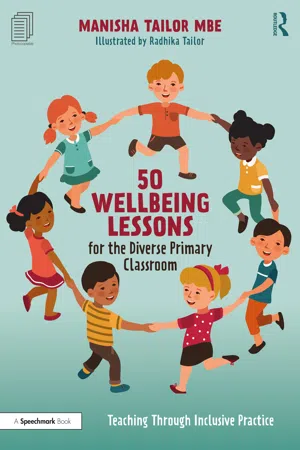
50 Wellbeing Lessons for the Diverse Primary Classroom
Teaching Through Inclusive Practice
- 202 pages
- English
- ePUB (mobile friendly)
- Available on iOS & Android
50 Wellbeing Lessons for the Diverse Primary Classroom
Teaching Through Inclusive Practice
About This Book
This book is designed to support teachers in promoting social and emotional wellbeing within their diverse classroom. With 50 detailed lessons plans and supplemented resources to promote discussion, each lesson plan contains learning outcomes, activity descriptions and further questions around areas of diversity specific to race, culture and LGBTQ+.
This accessible text offers a collection of activities with supplemented resources on a wide range of pertinent topics that challenge children to reflect, ask questions, analyse and find solutions through open discussion and collaboration. It provides them with the opportunity to explore their feelings and understand empathy and develop coping strategies in order to promote mental wellbeing. The content covered in this resource includes topics such as the psychological impact of discrimination, the Black Lives Matter movement, prejudice, coping with loss, feeling left out, moving school and managing as a young carer.
A practical guide ideal for those new to teaching as well as more experienced practitioners, this resource will help address social and emotional wellbeing through themes that often affect marginalised groups and is crucial reading for anyone looking to embed an inclusive mental wellbeing culture within their school.
Frequently asked questions
Information
Part I
Feelings and emotions
Activity 1
What is mental health?
Context
Learning outcomes
- Understand the definition of mental health
- Recognise and respond to a wider range of feelings
- Understand good and not so good feelings and associated language
- Recognise that they may experience conflicting emotions
- Reflect on what positively and negatively affects their mental health
Activity
Questions for thinking
- What do you understand by mental health?
- What does mental health mean to you?
- How do you think the characters in the resource are feeling?
- What might have happened to make the characters feel that way?
- Can you think of a time when you have experienced any of these feelings?
Resources
- Mental health jigsaw
- Mental health jigsaw (blank)
Mental health jigsaw

Mental health jigsaw (blank)

Activity 2
My mindful mind
Context
Learning outcomes
- Think about how to keep a mindful mind
- Recognise and respond to a wider range of feelings
- Understand good and not so good feelings and associated language
- Recognise that they may experience conflicting emotions
- Reflect on what positively and negatively affects their mental health
Activity
Table of contents
- Cover
- Half-Title
- Endorsements
- Title
- Copyright
- Contents
- About the Author
- Foreword
- Why teach about mental health in primary schools?
- Useful links
- Part I Feelings and emotions
- Part II Bullying
- Part III Growth and fixed mindset
- Part IV Understanding ourselves
- Part V Managing life at home
- Part VI Coping with loss and exclusion
- Part VII Resilience
- Part VIII Anxiety and depression
- Part IX Race, religion and culture
- Part X Relationships
- Part XI Disability